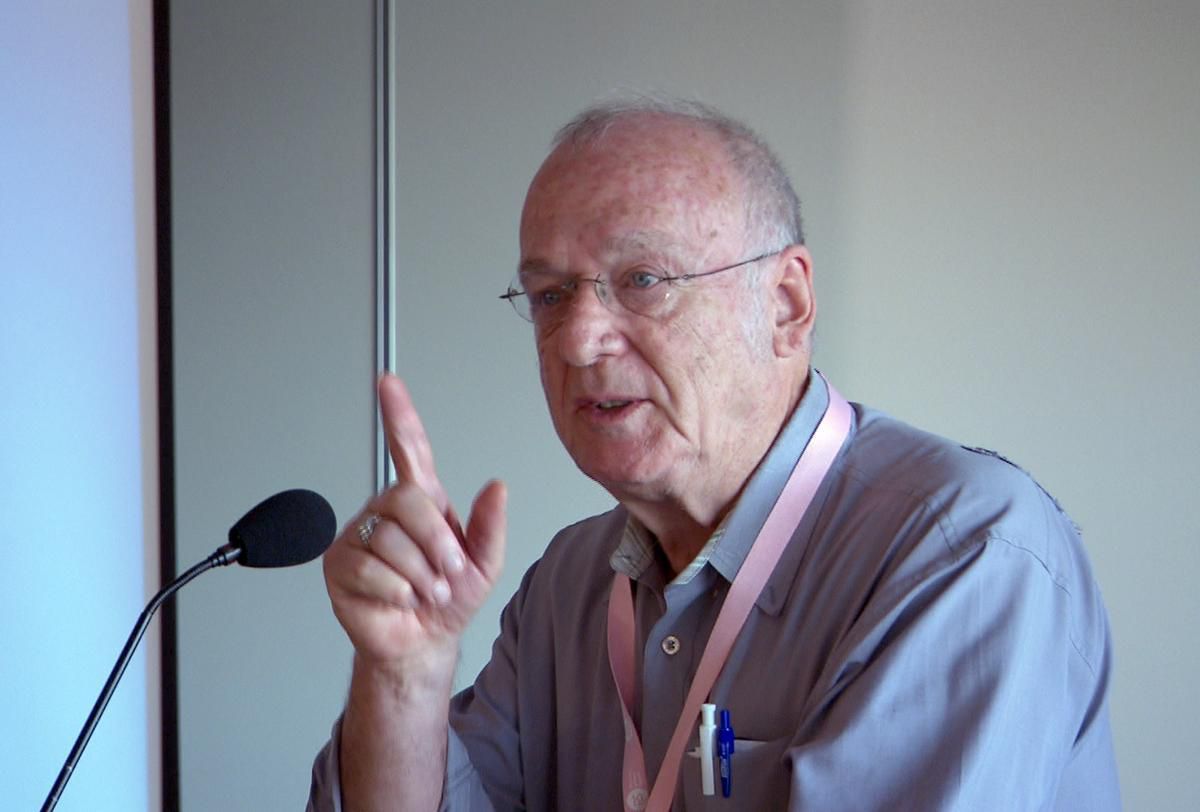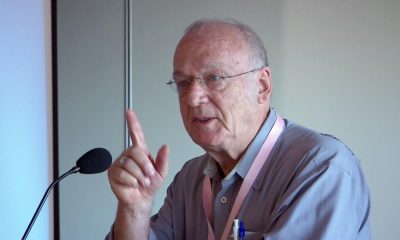Anglais
Inside the flawed world of medical publishing that allowed a lie in a paper coauthored by Dr. Gideon Koren to pollute the scientific record
Published
5 années agoon
By
admin
[ad_1]
In January 2000, a paper was published in a respected academic journal that trumpeted the successes of a Canadian lab in a burgeoning area of drug testing.
The researchers who wrote the paper claimed they had analyzed strands of hair to trace long-term exposure to illicit drugs, such as cocaine, and used gold-standard testing to verify its results.
/https://www.thestar.com/content/dam/thestar/news/investigations/2018/12/21/inside-the-flawed-world-of-medical-publishing-that-allowed-a-lie-in-a-paper-coauthored-by-dr-gideon-koren-to-pollute-the-scientific-record/_1_gideon_koren.jpg)
What everyone failed to notice — from the medical institution where the lab was housed to the federal agency that funded the study to the journal that published the article — was that the gold-standard claim was a lie.
In fact, Dr. Gideon Koren’s Motherisk lab at The Hospital for Sick Children rarely confirmed its results with gold-standard testing before 2010.
That lie was exposed in 2015, amid a scandal that tore apart vulnerable families and prompted two government-commissioned inquiries, which found Motherisk made millions selling its hair tests for use in criminal and child-protection cases despite the fact that it often failed to verify its preliminary results. This was contrary to international forensic standards for evidence presented in court.
The paper has been cited 54 times, as recently as May 2017. The journal told the Star this week that it will be “looking into these issues.”
Citations — when other researchers cite the study as a reference in their published work — is an indication of its influence.
A researcher’s publication record is the currency of modern-day science. It is the pre-requisite to securing competitive tenure-track positions at prestigious universities, the key to unlocking funding and the measure by which research institutions are assessed.
But it is a moment of reckoning for medical publishing. Last week, SickKids, which housed the Motherisk lab, announced it will undertake a wholesale review of Koren’s vast body of published work, after the Star presented the hospital with findings from this investigation that identified what appear to be problems in more than 400 of Koren’s papers, including the Jan. 2000 hair-testing article, collectively cited more than 6,000 times.
These papers appeared problematic because they have been inadequately peer-reviewed, failed to declare, and perhaps even obscure, conflicts of interest, and, in a handful of cases, contain lies about the methodology used to test hair for drugs.
We identified just 18 instances in the 400 studies flagged by the Star where it appears journals have taken action, in the form of a correction or clarification.
/https://www.thestar.com/content/dam/thestar/news/investigations/2018/12/21/inside-the-flawed-world-of-medical-publishing-that-allowed-a-lie-in-a-paper-coauthored-by-dr-gideon-koren-to-pollute-the-scientific-record/sickkids_hospital.jpg)
Sick Kids’ announcement follows a similar cases in the U.S. There, a research misconduct scandal recently prompted the resignation of Dr. Jose Baselga, the former chief medical officer of Memorial Sloan Kettering Cancer Centre in New York City, after a New York Times-ProPublica investigation found he failed to disclose payments from healthcare companies. Elsewhere, Ohio State University cancer scientist Ching-Shih Chen resigned after he was found to have falsified data.
The Star’s review of more than 1,400 papers co-written over 30 years by Koren, one of Canada’s most prolific scientific authors, reveals the inability — and unwillingness — of journals and research institutions to preserve the integrity of the scientific record.
Several concerns about Koren’s research were identified in 2015 by a SickKids internal review. The hospital posted a summary of its findings on its website, and told the Star it sent a copy to the province’s medical watchdog, which is investigating Koren.
The Star’s investigation has found the system of medical publishing is one with little accountability, where the onus is on authors to voluntarily disclose conflicts of interest. Journals don’t vet these claims (or the authors who make them). Institutions have discretion to investigate allegations of misconduct as they see fit.
Corrections, if they happen at all, routinely take years to be published.
The Star’s findings are consistent with the systemic problems that have been identified by Retraction Watch, a pioneering organization with an online database of retractions and corrections.
Founded in 2010, the organization began collecting retractions, by searching journals online and in print, and, by the time the database went live in October 2018, it had amassed more than 18,000 retractions. This made it the most extensive catalogue of such notices available, says the site’s co-founder, Ivan Oransky, a doctor, journalist and professor at New York University.
Despite the commonly held belief in the power of peer-review and the ability of academic publishing to root out cases of misconduct and fraud, Oransky describes “the vaunted self-correction mechanism of science” as one that is “held together by spit and bubble gum.”
From the institutions who rely on researchers to bring in grant money to the journals and authors whose reputations and careers are at stake, “at every stage the incentives are against doing the right thing,” he said.
“I don’t know if the barrel is totally rotten, but there are a lot more rotten apples in the barrel than people would like us to admit.”
Koren, who retired from SickKids in June 2015, has continued to publish since his departure. Neither he nor his lawyers responded to emails and phone calls seeking comment for this story.
Koren, who now lives in Israel, had been working as a senior researcher for Maccabi Health, a healthcare provider. In late October, Physicians for Human Rights Israel, a medical ethics’ watchdog, wrote to Maccabi Health with concerns that Maccabi may not know about Koren’s role in two SickKids controversies, including the Motherisk scandal. On Dec. 5, Maccabi, in a letter obtained by the Star, wrote back saying it had appointed a committee to “examine the role of Professor Koren in these incidents.”
Israel Hayom, a national newspaper, reported on Dec. 18, that Maccabi Health said Koren will be on leave until the end of the investigation. Haaretz, another Israeli newspaper reported that day that Koren defended the Motherisk lab by saying it was clinical, not forensic, and “won praise.” He said, according to the newspaper, that claims of biased or misleading research were outright libel.
SickKids said last week that it is “regrettable” that an audit of Koren’s work had not been conducted sooner and that there should have been “closer oversight of his disclosure and publication practices.”
In the 30 years he spent at the helm of Motherisk, Koren’s staggering publication record helped make the program the foremost source of advice for generations of pregnant women and their doctors. He held editorial positions at more than 15 academic journals, attracted more than $29 million in grants from public and private sources, won prestigious awards and supervised up to a dozen graduate students per year, the Star found.
The institutions and journals that benefited now face possible problems in hundreds of papers in a case that reveals problems ailing the system of academic publishing, and provides a prescription for much-needed improvement.
***
The Star’s findings were in many ways foretold 15 years ago, when the University of Toronto’s dean of medicine tried — and failed — to get a journal to retract one of Koren’s papers.
In April 2002, at a faculty council meeting, Dr. David Naylor, who is now interim CEO at SickKids, recorded a finding of research misconduct against Koren related to a 1999 study published in the journal Therapeutic Drug Monitoring.
The public chastisement was intended as a coda to Koren’s dispute with Dr. Nancy Olivieri, a blood diseases specialist at Sick Kids who, like Koren, held cross-appointments at U of T. Tensions boiled over while the pair was running a clinical trial with partial funding from the Canadian generic drug-maker Apotex. Olivieri voiced concerns about the efficacy of the drug, which Koren did not share.
/https://www.thestar.com/content/dam/thestar/news/investigations/2018/12/21/inside-the-flawed-world-of-medical-publishing-that-allowed-a-lie-in-a-paper-coauthored-by-dr-gideon-koren-to-pollute-the-scientific-record/nancy_olivieri.jpg)
In 2000, the heads of SickKids and U of T suspended and fined Koren, who was also stripped of an endowed chair for “repeatedly lying” and sending anonymous “poison pen letters” to doctors and the media disparaging Olivieri and her supporters. He denied writing the letters until DNA evidence provided irrefutable proof.
A committee formed by the U of T Faculty of Medicine found that Koren had published the 1999 paper without consulting the other researchers, failed to disclose Apotex’s support for the trial, and had not discussed the safety concerns about the drug.
“I sincerely hope that resolution of this … brings the entire episode to an end,” Naylor told the faculty council in 2002, according to the meeting minutes.
Naylor said that he insisted Koren write to the journal to acknowledge his error and request the article be deleted from the scientific record. “He has done so, and also sent appropriate personal letters of apology,” Naylor said, according to the minutes of the faculty council meeting. “I consider the matter closed.”
The article was never withdrawn.
An erratum was published in April 2004, stating that “the specific industry sponsor, Apotex Inc., of Weston, Ontario, was not mentioned.”
Koren’s failure to consult with his co-researchers and discuss the safety concerns, were not addressed in this correction.
In response to questions from the Star for this story, Naylor said Koren contacted the editor, Dr. Steven Soldin, within weeks of being notified of Naylor’s decision.
Naylor said Soldin was made aware of the “inappropriate use of shared data” and the “non-disclosure issue,” but that Soldin declined to retract the article.
Soldin, who is now a senior scientist at the National Institutes of Health Research in Maryland, told the Star he doesn’t recall a conversation with Koren about the paper after it was published and said he was never contacted by any official from U of T.
“If the Toronto academic faculty felt strongly about something, they should definitely have spoken with me,” he said. “It’s got to be a serious conversation, or it’s not going to be taken seriously.”
The matter was still outstanding when, in early 2004, Koren became North American editor of Therapeutic Drug Monitoring, based in part on the recommendation of his predecessor, Soldin.
In February 2004, Naylor wrote to Olivieri with an update. In that correspondance, obtained by the Star, Naylor said he wrote a letter urging retraction of the 1999 article, and, “as agreed,” Koren passed it to the publisher. In a recent email to the Star, Naylor said that he reached out to the publisher who rejected his request.
The current journal editor, Dr. Uwe Christians, said he “cannot comment further on the matter,” but, in general, “the journal editor and editorial board have full editorial independence; the publisher is not involved in editorial decisions.”
Arthur Schafer, founding director of the University of Manitoba’s Centre for Professional and Applied Ethics, said Koren should have been fired for his conduct in the Olivieri affair. That U of T and SickKids allowed him to continue publishing after his proven research misconduct, apparently without adequate oversight and supervision, is “astonishing,” he said.
Naylor, speaking in his capacity as U of T’s former dean of medicine, said he rejects the suggestion that the university’s “handling of this case somehow accounted for Koren’s ongoing failures to disclose industry funding sources and personal payments.”
“(Third) parties gave critical and wide public airing of Dr. Koren’s disclosure misconduct during and after these proceedings,” he said, referring to U of T’s investigation into the research misconduct allegations. “(His) aberrant conduct apparently continued regardless …. He was evidently impervious to discipline or criticism.”
A spokesperson for SickKids said that the issue surrounding the 1999 paper, “was addressed many years ago by the University of Toronto and the Hospital has no further comment.”
***
In his recent book, Doctors in Denial: Why Big Pharma and the Canadian Medical Profession are Too Close for Comfort, Dr. Joel Lexchin, a health policy expert at York University, writes that since the ’90s, pharma money has increasingly flowed to scientists who are regarded as having a favourable view of a company’s products and could be a willing, positive ambassador at conferences and dinners with colleagues.
Doctors who receive money from pharmaceutical companies “are almost uniformly resolute that they are promoting the product because they believe in its effectiveness and that they are independent and able to say what they believe,” Lexchin writes. He adds that “they sometimes indulge in self-censorship to avoid the risk of losing funding for research and attendance at conferences.”
In the U.S., federal law requires drug companies to disclose payments to doctors.
No such law exists in Canada.
Legislation, passed by Ontario’s former Liberal government last year to make these disclosures mandatory, has yet to be proclaimed by the new Tory government.
Dr. Andrew Boozary, an assistant professor at U of T and the co-founder of Open Pharma, a leading advocate for pharmaceutical payment transparency, said that there is no universal standard for disclosing conflicts of interest, ties to industry or anything else that could be seen to bias academic publishing.
When submitting a manuscript, authors are often asked to complete an online form that asks a simple “yes” or “no” question: “Are there any relevant conflicts of interest?”
Journal editors told the Star they rely on authors to be honest.
Koren has acknowledged in published papers and on one version of his C.V. that about 10 drug companies, including Pfizer, Duchesnay and Apotex, have provided him with money.
The Star found nearly 300 papers that contain concerns related to undisclosed, or possibly obscured, conflicts of interest. That includes roughly 30 papers that discuss morning sickness or Diclectin, the only medication approved by Health Canada to treat this condition, and do not acknowledge Koren’s long-term support from Duchesnay, the Quebec-based maker of the drug. Duchesnay provided funding to Koren beginning in 1994, according to his C.V.
Of the nearly 300 papers, about 270 cite “The Research Leadership for Better Pharmacotherapy During Pregnancy and Lactation.” SickKids, following its internal probe of Motherisk in 2015, said Koren created this name to refer to funds donated “by a variety of individuals and organizations.” In the years leading up to the Motherisk scandal, the primary donor was Duchesnay, the hospital said, and, in some cases where Koren used the “Research Leadership” name, he did not acknowledge funding from that drug company.
The Star requested a complete list of donors and the amount of money provided, but SickKids said this is “not possible,” because this was “not an actual fund set up at the hospital.”
In a statement, a spokesperson for Duchesnay confirmed the company “terminated its partnership with/and funding of” SickKids and Motherisk in 2015, but said “it is not our policy to announce the specific amounts it pays or has paid to Canadian health professionals for various consultations, speaker and research services.”
None of the other drug companies provided to the Star the amount or details of the funding to Koren or Motherisk.
Thomas Knudsen is editor-in-chief of the journal Reproductive Toxicology, which has published 13 papers co-written by Koren that the Star deemed problematic, because they relate to hair-testing, cite the Research Leadership name or discuss morning sickness or Diclectin without acknowledging support from Duchesnay.
Knudsen said that his editorial staff does not generally investigate conflict-of-interest disclosures. Peer reviewers are “not going to do a Google search” of the author, Knudsen said; their job is to review the science. Without a whistleblower or a note from a researcher’s institution, he asked, how was he supposed to know who or what to look into?
“We are not police officers,” he said.
“That’s up to the university.”
The journal published two more of Koren’s articles this year. A third was stopped by reviewers with concerns about the study design and conclusions. Knudsen recently rejected this study. He said that information provided by the Star about the findings of the news organization’s investigation into Koren’s papers, and the problems at Motherisk “made it easier” to render the “unfavourable” decision.
***
SickKids vowed to communicate the results of its recently announced review to “all involved journals.” This could prove a monumental task. The more than 400 papers identified by the Star as containing possible problems were published in roughly 75 journals and co-authored by more than 450 doctors, nurses and academics.
In these cases, publications can be slow to act, if they do at all, said Oransky of Retraction Watch.
Retractions, the most severe form of punishment a journal takes, are rare.
Corrections, known as “errata” or “corrigenda,” are more common.
But they can take years to materialize, are difficult to find and tend to be opaque.
In a search of three online scientific article databases, the Star found corrections related to 18 of the more than 400 articles we flagged.
Most are not appended to the online versions of the original articles.
The problems in the system were evident in our search for corrections related to five hair-testing papers that retired judge Susan Lang identified in her 2015 report on Motherisk as containing lies about using the gold-standard testing to confirm results.
/https://www.thestar.com/content/dam/thestar/news/investigations/2018/12/21/inside-the-flawed-world-of-medical-publishing-that-allowed-a-lie-in-a-paper-coauthored-by-dr-gideon-koren-to-pollute-the-scientific-record/susan_lang.jpg)
In her report, Lang said that Koren told her that he had sent erratum letters to the affected journals explaining the inaccuracies in these articles.
SickKids reiterated Koren’s claim in the press release last week.
Three years later, the Star’s online search found corrections related to two of those articles: an erratum related to a 2007 article published in Therapeutic Drug Monitoring, and a corrigendum related to a 2009 article published in Forensic Science International.
When asked why Forensic Science International did not publish a correction related to the 2000 paper discussed at the beginning of this story, the editor, Dr. Christian Jackowski said “no further corrigendum/erratum was published or provided by the author.”
The editor of a third journal, on request, sent the Star the corrigendum that was published in relation to a 2007 article.
None of these notices mentioned that the Motherisk lab has been discredited.
They claim that, despite the fact that results were not confirmed with gold-standard testing, this did not affect results.
Dr. Ronald Cohn, SickKids pediatrician-in-chief, took issue with Koren’s assertion that the gold-standard lie “had no impact on the results” of the study.
That prompted Therapeutic Drug Monitoring, one of the journals, to also issue an “expression of concern,” a stronger statement, about one of the articles.
Jackowski, the editor of Forensic Science International, said he told a SickKids official that he would additionally publish a letter to the editor stating the hospital’s position. But it was never submitted, he told the Star. SickKids told the Star it did send the letter, but would reach out to the journal again to clear up any misunderstanding.
Meanwhile, Dr. Togas Tulandi, the editor of Elsevier’s Journal of Obstetrics and Gynaecology Canada, which published an opinion piece by Koren in 2017, said that he was unaware of Koren’s research misconduct until he was contacted by the Star. He said his associate is “looking into it” and the journal may “withdraw (Koren’s) article.”
Therapeutic Drug Monitoring, which Koren edited until 2015, has recently taken the most aggressive approach of any journal towards Koren’s articles; Christians said the current president of the society that runs the journal asked Koren to step down as editor after he learned of the Motherisk scandal. Koren “accepted the termination without question,” he said.
In 2017, the journal reviewed all of the roughly 90 articles Koren co-authored, and sent 19 to independent reviewers for additional scrutiny. In seven, the reviewers recommended action, such as requesting proof of confirmation testing and ethics-board approval from the authors.
Christians said that the follow-up on these actions was delayed by the transition to a new editor, but that it “is now being prioritized.”
Following the Star’s inquiries, Christians said he is now considering retracting the 1999 paper that resulted in the research misconduct finding against Koren.
***
Naylor said Koren’s case is an “ugly and outsized” example of the systemic problems with conflicts of interest and protecting the scientific record.
The “only way to move forward,” he said, is for institutions to keep better tabs on researchers’ financial relationships, ensure the penalties for not disclosing are clear and collaborate with journal editors to “work out a more explicit system” to share information and “oversight of the processes for correcting the scientific record.”
Naylor said it would be “a huge help if all industry payments made directly to physicians were simply disclosed publicly by the payers.”
Koren continues to submit manuscripts to journals to be considered for publication.
He published a study in August about a severe form of morning sickness. The paper acknowledges he is “a consultant for Duchesnay.”
In September, Koren was singled out among the world’s “hyperprofilic” authors in an article in Nature. These were researchers who wrote more than 72 papers in any year from 2000 to 2016 — roughly one paper every five days — which, the study authors noted, “many would consider implausibly prolific.”
Lead author, Stanford University professor John Ioannidis, said the study is an attempt to understand hyper-prolific authorship, for better or worse.
Koren responded to a request from the study authors to comment on his output. He credited teamwork, 16-hour work days, and two “very supportive work environments.”
“I perceive myself as an individual who is highly committed to scientific discovery,” he said. “I do not feel I have to apologize for my high productivity.”
With files from Tania Pereira, May Warren, Stefanie Marotta, Jason Miller and Brendan Kennedy.Ryerson note: The Star’s investigation into Koren’s publications was conducted in partnership with Ryerson University School of Journalism students Stefanie Phillips, Emerald Bensadoun, Kate Skelly and Alanna Rizza.
Rachel Mendleson is a Toronto-based investigative reporter. Follow her on Twitter: @rachelmendleson
Michele Henry is a Toronto-based investigative reporter. Follow her on Twitter: @michelehenry
TOP STORIES, DELIVERED TO YOUR INBOX.
[ad_2]
Source link
You may like
-


Don’t allow cannabis edibles that look like candy, medical officer of health says
-


Biathlon World Cup sprint races cancelled due to frigid temperatures
-


‘We’re holding up a floodgate’: B.C. fights off superbugs brought home by medical tourists
-


Le détenteur d’un record à Fortnite avoue avoir menti sur son âge
-


Canadian case is another warning about the murky world of cryptocurrency: Don Pittis
-


Medical journal corrects two flawed articles by Dr. Gideon Koren
Anglais
Nostalgia and much more with Starburst XXXtreme
Published
3 années agoon
août 10, 2021By
admin
Get a taste of adventure with Starburst XXXtreme based on the legendary NetEnt Game. The nostalgic themes are sure to capture fans of the classic version as they get treated to higher intensity, better visuals, and features. The most significant element of the game is its volatility. Patience will not be an essential virtue considering the insane gameplay, and there is a lot of win potential involved. It retains the original makeup of the previous game while adding a healthy dose of adrenaline.
Starburst Visuals and Symbols
The game is definitely more conspicuous than before. The setting happens over a 5-reel, 3-row game grid with nine fixed win lines, which function if a succession from the left to the right reel is present. Only those players that that attain the highest win per bet line are paid. From a visual standpoint, the Starburst XXXtreme slots illustrates lightning effects behind the reels, which is not surprising as it is inherited from the original version. Available themes include Classic, Jewels, and Space. The game is also available in both desktop and mobile versions, which is advantageous for players considering the global pandemic. According to Techguide, American gamers are increasingly having more engaging gaming experiences to socialize to fill the gap of in-person interaction. Starburst XXXtreme allows them to fill the social void at a time when there is so much time to be had indoors.
Starburst XXXTreme Features
Players get to alternate on three features which are Starburst Wilds, XXXtreme Spins, and Random Wilds. The first appears on reels 2,3, or 4. When these land, they expand to cover all positions while also calculating the wins. They are also locked for a respin. If a new one hits, it also becomes locked while awarding another respin. Starburst XXXtreme offers a choice between two scenarios for a higher stake. In one scenario with a ten times stake, the Starburst Wild is set on random on reels 2,3, or 4, and a multiplier starts the respin. The second scenario, which has a 95 times stake, starts with two guaranteed starburst wilds on reels 2,3, or 4. it also plays out using respin game sequence and features. The game also increases the potential with the Random Wilds feature to add Starburst Wilds to a vacant reel at the end of a spin. Every Starburst Wild gives a random multiplier with potential wins of x2, x3, x5, x10, x25, x50, x100, or even x150.
The new feature is sure to be a big hit with the gaming market as online gambling has shown significant growth during the lockdown. AdAge indicates the current casino customer base is an estimated one in five Americans, so Starburst XXXtreme’s additional features will achieve considerable popularity.
What We Think About The Game
The gambling market has continued to diversify post-pandemic, so it is one of the most opportune times to release an online casino-based game. Thankfully Starburst XXXtreme features eye-catching visuals, including the jewels and space themes. These attract audience participation and make the gameplay inviting. The game also has a nostalgic edge. The previous NetEnt iteration featured similar visuals and gameplay, so the audience has some familiarity with it. The producers have revamped this version by tweaking the features to improve the volatility and engagement.
That is characterized by the potential win cap of 200,000 times the bet. Starburst XXXtreme does not just give betting alternatives for players that want to go big. The increase of multipliers also provides a great experience. If the respins in the previous version were great, knowing that multipliers can go hundreds of times overtakes the game to a new level.
Players should get excited about this offering. All of the features can be triggered within a single spin. Whether one plays the standard game or takes the XXXtreme spin route, it is possible to activate all of the features. Of course, the potential 200,000 times potential is a huge carrot. However, the bet size is probably going to be restricted and vary depending on the casino. It is also worth pointing out that a malfunction during the gameplay will void all of the payouts and progress. Overall, the game itself has been designed to provide a capped win of 200,000 times the original bet.
Anglais
‘We’re back’: Montreal festival promoters happy to return but looking to next year
Published
3 années agoon
juillet 23, 2021By
admin
In downtown Montreal, it’s festival season.

In the city’s entertainment district, a musical act was conducting a sound check on stage Friday evening — the second day of the French-language version of the renowned Just For Laughs comedy festival. Tickets for many of the festival’s free outdoor shows — limited by COVID-19 regulations — were sold out.
Two blocks away, more than 100 people were watching an acoustic performance by the Isaac Neto Trio — part of the last weekend of the Festival International Nuits d’Afrique, a celebration of music from the African continent and the African diaspora.
With COVID-19 restrictions continuing to limit capacity, festival organizers say they’re glad to be back but looking forward to next year when they hope border restrictions and capacity limits won’t affect their plans.
Charles Décarie, Just For Laughs’ CEO and president, said this is a “transition year.”
“Even though we have major constraints from the public health group in Montreal, we’ve managed to design a festival that can navigate through those constraints,” Décarie said.
The French-language Juste pour rire festival began on July 15 and is followed by the English-language festival until July 31.
When planning began in February and March, Décarie said, organizers came up with a variety of scenarios for different crowd sizes, ranging from no spectators to 50 per cent of usual capacity.
“You’ve got to build scenarios,” he said. “You do have to plan a little bit more than usual because you have to have alternatives.”

Anglais
MELS new major movie studio to be built in Montreal
Published
3 années agoon
juillet 23, 2021By
admin
MONTREAL — MELS Studios will build a new film studio in Montreal, filling some of the gap in supply to meet the demand of Hollywood productions.
MELS president Martin Carrier said on Friday that MELS 4 studio construction will begin « as soon as possible », either in the fall or winter of next year. The studio could host productions as early as spring 2023.
The total investment for the project is $76 million, with the Quebec government contributing a $25 million loan. The project will create 110 jobs, according to the company.
The TVA Group subsidiary’s project will enable it to stand out « even more » internationally, according to Quebecor president and CEO Pierre Karl Péladeau. In the past, MELS Studios has hosted several major productions, including chapters of the X-Men franchise. The next Transformers movie is shooting this summer in Montreal.
Péladeau insisted that local cultural productions would also benefit from the new facility, adding that the studio ensures foreign revenues and to showcase talent and maintain an industry of Quebec producers.
STUDIO SHORTAGE
The film industry is cramped in Montreal.
According to a report published last May by the Bureau du cinéma et de la télévision du Québec (BCTQ), there is a shortage of nearly 400,000 square feet of studio space.
With the addition of MELS 4, which will be 160,000 square feet, the company is filling part of the gap.
Carrier admitted that he has had to turn down contracts because of the lack of space, representing missed opportunities of « tens of millions of dollars, not only for MELS, but also for the Quebec economy. »
« Montreal’s expertise is in high demand, » said Montreal Mayor Valérie Plante, who was present at the announcement.
She said she received great testimonials from « Netflix, Disney, HBO and company » during an economic mission to Los Angeles in 2019.
« What stands out is that they love Montreal because of its expertise, knowledge and beauty. We need more space, like MELS 4, » she said.
There is still not enough capacity in Quebec, acknowledged Minister of Finance, the Economy and Innovation Eric Girard.
« It is certain that the government is concerned about fairness and balance, so if other requests come in, we will study them with the same seriousness as we have studied this one, » he said.
Grandé Studios is the second-largest player in the industry. Last May, the company said it had expansion plans that should begin in 2022. Investissement Québec and Bell are minority shareholders in the company.
For its part, MELS will have 400,000 square feet of production space once MELS 4 is completed. The company employs 450 people in Quebec and offers a range of services including studio and equipment rentals, image and sound postproduction, visual effects and a virtual production platform.


MAPEI Canada inaugure l’agrandissement de son usine à Laval, au Québec

Le Gala Elles reconnaissent célèbre les femmes remarquables de l’industrie de la construction

Préparez votre maison pour l’hiver afin d’éviter les réclamations d’assurance

Quatre façons de commencer à travailler dans le domaine des ventes

La Commission indépendante soutient le recours de la Cour suprême contre le déni des droits des non-francophones par le Québec

Justin Trudeau est un raciste contre les Noirs et les Premières Nations – 14 signes

Enfants aux études loin de la maison : Trois conseils pour veiller à la santé de leurs finances

Règles et règlements que toutes les entreprises canadiennes doivent connaître

Épargnez pour l’avenir grâce à nos trucs financiers pour la rentrée

Efficacité énergétique: 10 façons économiques de l’améliorer

Ces légendes du baccara vous dévoilent leurs secrets

Retard de vol : le devoir de la compagnie envers ses passagers

Nostalgia and much more with Starburst XXXtreme

Même les jeunes RÉPUBLIQUES se lassent du capitalisme, selon les sondeurs américains — RT USA News

« Aucune crise climatique ne causera la fin du capitalisme ! »

Innovation : le capitalisme « responsable », faux problème et vraie diversion

Vers la fin du Capitalocène ?

Le “capitalisme viral” peut-il sauver la planète ?

Livre : comment le capitalisme a colonisé les esprits

Patrick Artus : « Le capitalisme d’aujourd’hui est économiquement inefficace »

Body found after downtown Lethbridge apartment building fire, police investigating – Lethbridge

Comment aider un bébé à développer son goût

Head of Toronto Community Housing placed on paid leave

Salon du chocolat 2018: les 5 temps forts

This B.C. woman’s recipe is one of the most popular of all time — and the story behind it is bananas

Gluten-Free Muffins

We Try Kin Euphorics and How to REALLY Get the Glow | Healthyish

Man facing eviction from family home on Toronto Islands gets reprieve — for now

Condo developer Thomas Liu — who collected millions but hasn’t built anything — loses court fight with Town of Ajax

27 CP Rail cars derail near Lake Louise, Alta.

Ontario’s Tories hope Ryan Gosling video will keep supporters from breaking up with the party

Renaud Capuçon, rédacteur en chef du Figaroscope

Paris : chez Cécile Roederer co-fondatrice de Smallable

Ontario Tories argue Trudeau’s carbon plan is ‘unconstitutional’

100 years later, Montreal’s Black Watch regiment returns to Wallers, France

Trudeau government would reject Jason Kenney, taxpayers group in carbon tax court fight

Ford Ranger Raptor, le pick-up roule des mécaniques

Le Forex devient de plus en plus accessible aux débutants

Los Angeles poursuit The Weather Channel pour atteinte à la vie privée

The Bill Gates globalist vaccine depopulation agenda… as revealed by Robert F. Kennedy, Jr.
Trending
-

 Anglais5 années ago
Anglais5 années agoBody found after downtown Lethbridge apartment building fire, police investigating – Lethbridge
-

 Santé Et Nutrition4 années ago
Santé Et Nutrition4 années agoComment aider un bébé à développer son goût
-

 Anglais5 années ago
Anglais5 années agoHead of Toronto Community Housing placed on paid leave
-

 Styles De Vie5 années ago
Styles De Vie5 années agoSalon du chocolat 2018: les 5 temps forts
-

 Anglais5 années ago
Anglais5 années agoThis B.C. woman’s recipe is one of the most popular of all time — and the story behind it is bananas
-

 Santé Et Nutrition5 années ago
Santé Et Nutrition5 années agoGluten-Free Muffins
-

 Santé Et Nutrition5 années ago
Santé Et Nutrition5 années agoWe Try Kin Euphorics and How to REALLY Get the Glow | Healthyish
-

 Anglais5 années ago
Anglais5 années agoMan facing eviction from family home on Toronto Islands gets reprieve — for now


